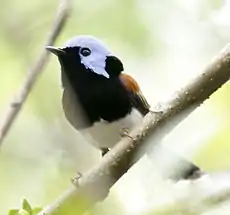Lovely fairywren
The lovely fairywren (Malurus amabilis), or lovely wren, is a species of bird in the Australasian wren family, Maluridae. It is endemic to northeastern Australia. Its natural habitats are subtropical or tropical dry forest and subtropical or tropical moist lowland forest.
| Lovely fairywren | |
|---|---|
 | |
| Scientific classification | |
| Kingdom: | Animalia |
| Phylum: | Chordata |
| Class: | Aves |
| Order: | Passeriformes |
| Family: | Maluridae |
| Genus: | Malurus |
| Species: | M. amabilis |
| Binomial name | |
| Malurus amabilis Gould, 1852 | |
Taxonomy and systematics
The lovely fairywren was first described by the ornithologist John Gould in 1852, from a specimen collected by Captain Owen Stanley in Cape York.[2] Its species name is the Latin adjective ămābǐlis "lovable".[3] It is one of eleven species of the genus Malurus, commonly known as fairywrens, found in Australia and lowland New Guinea. Within the genus it belongs to a group of four very similar species known collectively as chestnut-shouldered fairywrens. The other three species are the variegated fairywren, red-winged fairywren, and the blue-breasted fairywren.[4] A 2011 analysis of mitochondrial and nuclear DNA found that the lovely fairywren is nested within the variegated fairywren complex, and is the sister taxon of the purple-backed fairywren.[5]
Description
Like other fairywrens, the lovely fairywren is notable for its marked sexual dimorphism, males adopting a highly visible breeding plumage of brilliant iridescent blue and chestnut contrasting with black and grey-brown. The brightly coloured crown and ear tufts are prominently featured in breeding displays.[6] The male in breeding plumage has striking azure blue ear coverts, crown and upper back, a black throat and nape, chestnut shoulders and a white-tipped blue tail. The wings are black and the belly white. The female has smoky blue upperparts and tail, with turquoise ear tufts, and dark grey wings, and white below. Both sexes have black bills, brown eyes and flesh-grey feet. Immature birds resemble females but have brown bills.[2]
References
- BirdLife International (2016). "Malurus amabilis". IUCN Red List of Threatened Species. 2016: e.T22703748A93935095. doi:10.2305/IUCN.UK.2016-3.RLTS.T22703748A93935095.en.
- Rowley & Russell 1997, p. 165
- Simpson 1979, p. 38
- Rowley & Russell 1997, p. 159
- Driskell et al. 2011
- Rowley & Russell 1997, pp. 43–44
Works cited
- Driskell, Amy C.; Norman, Janette A.; Pruett-Jones, Stephen; Mangall, Elizabeth; Sonsthagen, Sarah; Christidis, Les (2011). "A multigene phylogeny examining evolutionary and ecological relationships in the Australo-papuan wrens of the subfamily Malurinae (Aves)". Molecular Phylogenetics and Evolution. 60 (3): 480–85. doi:10.1016/j.ympev.2011.03.030. PMID 21466855.CS1 maint: ref=harv (link)
- Rowley, Ian; Russell, Eleanor (1997). Bird Families of the World: Fairy-wrens and Grasswrens. Oxford: Oxford University Press. ISBN 0-19-854690-4.CS1 maint: ref=harv (link)
- Simpson, D.P. (1979). Cassell's Latin Dictionary (5th ed.). London: Cassell. ISBN 0-304-52257-0.CS1 maint: ref=harv (link)
